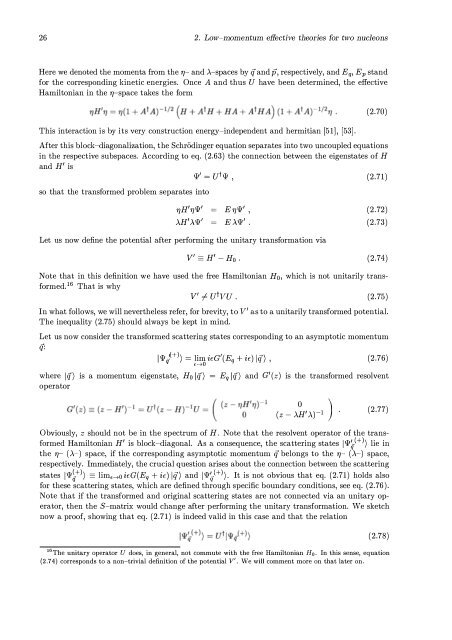The Nucleon-Nucleon Interaction in a Chiral Effective Field Theory
The Nucleon-Nucleon Interaction in a Chiral Effective Field Theory
The Nucleon-Nucleon Interaction in a Chiral Effective Field Theory
Create successful ePaper yourself
Turn your PDF publications into a flip-book with our unique Google optimized e-Paper software.
26 2. Low-momentum effective theories for two nucleons<br />
Here we denoted the momenta from the TJ- and ),-spaces by if and p, respectively, and Eq, Ep stand<br />
for the correspond<strong>in</strong>g k<strong>in</strong>etic energies. Once A and thus U have been determ<strong>in</strong>ed, the effective<br />
Hamiltonian <strong>in</strong> the TJ-space takes the form<br />
This <strong>in</strong>teraction is by its very construction energy-<strong>in</strong>dependent and hermitian [51], [53] .<br />
(2.70)<br />
After this block-diagonalization, the Schröd<strong>in</strong>ger equation separates <strong>in</strong>to two uncoupled equations<br />
<strong>in</strong> the respective subspaces. Accord<strong>in</strong>g to eq. (2.63) the connection between the eigenstates of H<br />
and H' is<br />
w' = utw ,<br />
(2.71)<br />
so that the transformed problem separates <strong>in</strong>to<br />
TJH'TJW'<br />
),H' ),w'<br />
ETJW' ,<br />
E),w' .<br />
Let us now def<strong>in</strong>e the potential after perform<strong>in</strong>g the unitary transformation via<br />
v' == H' -Ho .<br />
(2.72)<br />
(2.73)<br />
(2.74)<br />
Note that <strong>in</strong> this def<strong>in</strong>ition we have used the free Hamiltonian Ho, which is not unitarily transformed.16<br />
That is why<br />
v' i= U t VU . (2.75)<br />
In what follows, we will nevertheless refer, for brevity, to V' as to a unitarily transformed potential.<br />
<strong>The</strong> <strong>in</strong>equality (2.75) should always be kept <strong>in</strong> m<strong>in</strong>d.<br />
Let us now consider the transformed scatter<strong>in</strong>g states correspond<strong>in</strong>g to an asymptotic momentum<br />
if:<br />
IWq'<br />
� (+) ) = lim iEG'(Eq + iE) lif) ,<br />
(2.76)<br />
f--+O<br />
where Iq) is a momentum eigenstate, Ho Iq) = Eq Iq) and G'(z) is the transformed resolvent<br />
operator<br />
o<br />
(z - ),H' ),)-1 )<br />
. (2.77)<br />
Obviously, z should not be <strong>in</strong> the spectrum of H. Note that the resolvent operator of the transformed<br />
Hamiltonian H' is block-diagonal. As a consequence, the scatter<strong>in</strong>g states IW:Z(+)) lie <strong>in</strong><br />
the TJ- (),-) space, if the correspond<strong>in</strong>g asymptotic momentum if belongs to the TJ- (),-) space,<br />
respectively. Immediately, the crucial question arises about the connection between the scatter<strong>in</strong>g<br />
states Iw�+)) == limHo iEG(Eq + iE) lif) and Iw:z(+)). It is not obvious that eq. (2.71) holds also<br />
for these scatter<strong>in</strong>g states, which are def<strong>in</strong>ed through specific boundary conditions, see eq. (2.76).<br />
Note that if the transformed and orig<strong>in</strong>al scatter<strong>in</strong>g states are not connected via an unitary operator,<br />
then the S-matrix would change after perform<strong>in</strong>g the unitary transformation. We sketch<br />
now a proof, show<strong>in</strong>g that eq. (2.71) is <strong>in</strong>deed valid <strong>in</strong> this case and that the relation<br />
(2.78)<br />
16<strong>The</strong> unitary operator U does, <strong>in</strong> general, not commute with the free Hamiltonian Ho . In this sense, equation<br />
(2.74) corresponds to a non-trivial def<strong>in</strong>ition of the potential V' . We will comment more on that later on.












